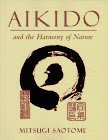I read somewhere in an article that there are three ways to do an aikido technique.
- where the uke grabs the tori and holds his arms hard trying to prevent him from moving. Obviously, the challenge here for the tori is to start the technique and then finish it as well as he can.
- when the uke has some attacking speed (plus the initiative). The tori doesn't have to focus hard on getting out of uke's grasp but he can do a technique in a bit more relaxed manner, the uke won't struggle trying to hit or kick you (or holding you down/back), and you can do the technique in harmony.
- when it's the tori who initiates the movements by making the uke come forward and attack. After this initial movement you work together as normally.
The first point is what beginners tend to do every time. This is the 'what if I hold you like this, what if I come back here and kick you here' approach. If I do a technique slowly, the result with beginners will obviously be this and there's hardly any harmony in it (which we should achieve). If I do this quickly with a beginner they may get injured. Struggling is not aikido anyway. Unless, you are specifically asked to do techniques this way, e.g., ushiro kubishime.
The third point, where tori takes the initiative, is ok as long as both of you have some aikido experience. This one is a bit weird if you do a technique slowly. Changing the speed during the execution of a technique is not really realistic neither it is advised. Changing the speed like this can be dangerous, especially for beginners who tend to speed up once they think how to do that part of the technique. For example, if someone attacks you slowly with a shomenuchi you should react with the same speed to work in harmony. However, if you are a beginner you are often late with starting a technique which you sometimes may try to compensate with rapid (and not stable) execution.
The second way of doing a technique, though, can be practiced by everyone, you can focus on doing the technical details well, do the technique in harmony and beginners can be taught to work without struggle and, at the same time, without being too relaxed ('cool'). Also, you can do techniques slowly.
I prefer seeing when an instructor demonstrates two ways at a time: 'You can do it this way, you can do it that way but never mix the two and, especially, never switch between these two ways within the execution of a technique'. One of the best examples comes from jo exercises: when you finish a technique with a tsuki, you can stop the end of the jo near to the head of the opponent or you can thrust properly (stopping the jo's tip behind the head) but next to the head... you can imagine what happens when you mix the two.
If there is a hole in this theory I hope someone will correct me in the comments :).
ps. After reading back my post, it seems that the three-way theory might be ok but needs advanced students to practice them. I wouldn't teach the 'hold the other' method to beginners as they are never soft and relaxed (which is understandable, this is one of the reasons they start training). I would teach the 3rd method in an easy manner to carefully show beginners when they need to keep attacking (as they often tend to stop in the middle).
Let's work in harmony.










1 comment:
lovely article Zolley, carry on! And my one is coming soon, I promise!!!!
Uff
Post a Comment